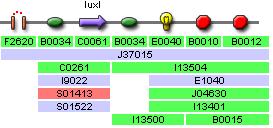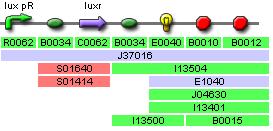IGEM:IMPERIAL/2006/project/Oscillator/Parts: Difference between revisions
| Line 62: | Line 62: | ||
===AiiA | ===AiiA Activity Assay=== | ||
<br> | <br> | ||
*<big>'''[http://parts.mit.edu/registry/index.php/Part:BBa_I13207 I13207]''' - 2P Plate 1</big> | *<big>'''[http://parts.mit.edu/registry/index.php/Part:BBa_I13207 I13207]''' - 2P Plate 1</big> | ||
| Line 85: | Line 85: | ||
*[http://parts.mit.edu/registry/index.php/Part:BBa_C0160 C0160] - 9F Plate 1 (Non-LVA tagged AiiA) | *[http://parts.mit.edu/registry/index.php/Part:BBa_C0160 C0160] - 9F Plate 1 (Non-LVA tagged AiiA) | ||
===Important Notes=== | ===Important Notes=== | ||
Revision as of 05:46, 18 July 2006
Parts for Final Assembly
- BBa_F2620 (quorum sensing receiver LuxR) well 6B, plate 1 (available and working)
- BBa_F2621 (quorum sensing receiver LuxR) well 4N, plate 1 (available and working)
- BBa_I0460 (AiiA enzyme coding) well 11I, plate 1 (available)
- BBa_F1610 (quorum sensing sender LuxI) well 1B, plate 2 (available and working)
Have questions about this, not sure these are the parts we need? - TomH
Parts for Testing Phase
- BBa_E0040 (GFPuv) well 5H, plate 1 (available and working)
- BBa_T9002 (controlling GFP) well 19B, plate 2 (available and working)
- BBa_I13207 (HSL/AiiA test construct) well 2P, plate 1 (available)
- BBa_I13272 (Test receiver in predator) well 4F, plate 1 (available and working)
- BBa_M0032 (C-myc tag) not available
- BBa_I0403 (AiiA enzyme with CYFP) well 5P, plate 1 (available)
Prey Transfer Fuction Characterisation/AHL Assay Cell
- T9002 - 19B Plate 2
This construct is used to measure the ability of AHL to activate gene expression from pLuxR. LuxR expression can also be modulated from pTet to work out how LuxR levels effect pLuxR activation. We can then use this data to plot a calibration curve of Activation vs AHL concentration.
Question: Can we, and do we need to, find out how LuxR expression is effected by varying TetR levels?
Prey Cell Positve Feeback Test
This construct is used to characterise the positive feedback loop, with AHL levels being determined by the assay construct above.
- F2620 - 6B Plate 1
- C0261 - 24A Plate 1
- E0434 - 20J Plate 1 (Plasmid Unknown)
Predator Transfer Function Characterisation
This construct is used to characterise the pLuxR transfer function, and noteably its effect on YFP expression, which would be equivalent to AiiA expression in the full system.
Question: Thinking about it, wouldn't it be better to decouple LuxR expression from pLuxR, and make it constitutive?
AiiA Activity Assay
- I13207 - 2P Plate 1
OR
This construct allows us to measure AiiA expression with the couple to YFP, and also AHL levels (and therefore catalytic activity) of AiiA using the AHL assay construct.
- C0160 - 9F Plate 1 (Non-LVA tagged AiiA)
Important Notes
May be necessary to add TetR and LacI coding regions to the constructs requiring those promoters to allow control.
Both LacI and TetR require prescence of inducer to work. Do we want this in final construct? If not, do we need to change the promoters used?
E-mail from Mr. Barry Canton of MIT regarding parts
16 July 2006: Parts for Final Project
Hi John, I was forwarded your email below as I have done some work with the quorum sensing systems you are asking about.
Specifically, we tested F1610 as part of I13015 and showed that it could induce receiver cells. We tested F2621 a little bit and showed that it could be induced by the sender cells. I believe the transfer curve looked very similar to that of F2620 but I would have to try and find the data for that.
Most of our testing was with F2620. The best place to read about our characterization of F2620 is on openwetware by going to this page - http://openwetware.org/wiki/Endy:F2620 All the experiments we have done are described there.
You are asking about time to send and receive signals. We haven't done much work on transport times for the molecules through liquid media or over solid media but if you can specify what the experimental set-up is I might have some qualitative comments. Our experience has been that the receivers activate transcription within minutes after addition of HSL to liquid media.
Ron Weiss at Princeton has done some tests where he looked at receiver cells placed at different distances from sender cells. He made some movies showing the closer receivers being induced first. I think that some of that data should be available in his papers.
Anyway, let me know if you have some specific questions and I can try and give you more specific info.
Good luck with the oscillators, I'll be watching the progress on OWW!
Barry
16 July 2006: AiiA Testing Construct
Hi John, we did very little testing with I13207 and the results were not especially conclusive. Had we continued the testing somewhat more rigorously, we may have had better results.
If you download the presentation linked below, which we gave at the Jamboree in 2004 you can have a look at slide 41 which has some of the data we got for I13207. Basically we induced receiver cells in the presence or absence of arabinose which should induce aiia production. The drawback of that experiment was that we were using MC4100 for which arabinose is toxic. You might have better results in another strain. I just had time to transform into MG1655 and do one experiment before I switched over to working full time on my thesis project. The results in that experiment suggested that there was low levels of induction of the receiver when aiiA was expressed. I was inducing with 0.02% arabinose at the time.
All our experiments with these receiver devices were basically the same. Grow an ovenight in supplemented M9, dilute back 1/500 in the morning, wait until an OD of ~0.1 and then induce with HSL and arabinose if appropriate. We use a 96 well plate reader to measure GFP accumulation over time. You can read more about the experimental set-up on the F2620 page of OWW, its basically the same.
Hope this is of some use and let me know if you have further questions,
Barry




